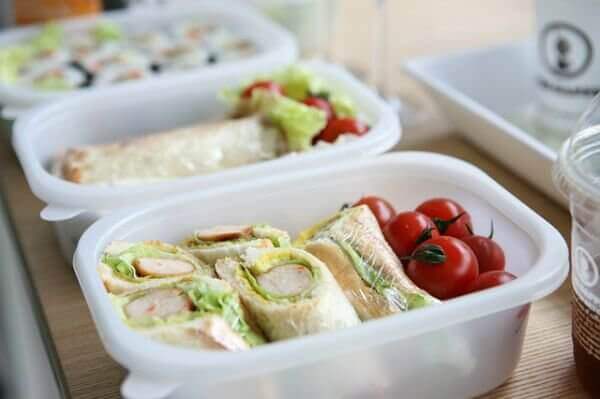How to Help Picky Eaters Eat Healthy School Lunches
There’s an unspoken stigma amongst moms these days, namely “picky eaters are created by moms who cater to their kid’s every whim.” Or better said, your kid wouldn’t be a picky eater if you didn’t LET him be.
And while an element of this certainly may be true, picky eating isn’t quite that simple.
Sure, the concept of a “picky eater” is largely a first-world one. But that doesn’t mean it’s not REAL or not worth our attention. Nor does it diminish the frustration and anguish of parents who deal with children who are picky eaters.
What Causes Picky Eating?
Picky eating shows up in affluent upper-class homes as well as those who fill their pantries via the food bank and food stamps – there’s no one group that has the “market cornered” on picky eating.
Also, picky eaters come about for a number of reasons, which range from psychological to hormonal to relational to behavioral. This is why often toddlers will love a certain food, then suddenly when they turn two or three, won’t touch that favorite food for anything. For my five-year-old, it’s currently zucchini. Last year he would eat an entire zucchini on his own, but this year as we’ve begun pulling our treasures out of the garden, he won’t touch it, even though he helps harvest it and he’s proud as peaches of getting to carry them all into the house.
I appreciate this quote from Dr. Sears (even though I would also insert “grow” next to the word “buy”):
“We now realize that our job is simply to buy the right food, prepare it nutritiously…, and serve it creatively… we’ve learned to take neither the credit nor the blame if our children go through a picky eater stage.” (source)
Basically, what I’m trying to say is that we need to exercise a bit of grace towards each other (and our children), then dive in and get excited about helping our children delight in their food, while setting a few guidelines along the way.
The key is to remember that picky eating WILL pass. It may not be until adulthood (as Stephanie has written about so wonderfully) or it may be next year, but it WILL pass. In the meantime, continuing to offer those foods that are assumed to be verboten is absolutely important. It can sometimes take up to 40 times of being exposed to something new before we even “see” it, and the same is true with tastes and textures. In our house, we have the rule that you have to take at least one bite of everything at each meal, even if every time you decide you still don’t like it.
The Bigger Picture
Food should be fun! I’m not advocating playing with food and making a mess (except on purpose), but I am saying that the MUCH BIGGER PICTURE is that we’re in the business of teaching our children to delight in mealtimes and to delight in their food, which will ultimately result in a much healthier relationship with food. If mealtimes descend into battlegrounds on a regular basis, this is quashed and food choices are more about the power struggle than about enjoying each other’s company around a meal.
If that’s the case in your family, perhaps try resetting your dinnertime by removing the central focus from the food itself and focusing more on telling stories around the dinner table, laughing together, and setting very simple rules you know your children can meet so that everyone looks forward to mealtime more, your kiddos become more confident by regularly accomplishing their goals, and in that environment become more open to trying new things.
And if you’re worried about your child because you’re afraid he’s missing out on certain nutrients, get creative. Did you know pineapple and kiwi have more Vitamin C than oranges? Or that bell peppers, other brightly colored vegetables, and even red palm oil have equal or more beta carotene than carrots? What I’m saying is that there are multiple ways to get a wide-complement of vitamins and minerals into your child’s diet through whole foods and your child will likely eat at least one of them (even if that may require pureeing it in a sauce or serving it up in a popsicle).
But What About When My Child is Away from Home?
Now – we’ve also got a second hurdle to deal with. It’s one thing to deal with a picky eater at home when you can be present at meals and encourage him or her to try new foods, but what do you do when your child is away from home – namely school or camp?
Here are three sure-fire strategies I’ve found for helping picky eaters actually eat that healthy school lunch waiting for them in their backpack. Of course, not every single one will work for your child, but I’ve purposely called them “sure-fire” because I’ve seen nearly every child who has tried them become more adventurous in their eating habits over the course of a few weeks or months.
And if they don’t, there’s one more idea listed at the end. 🙂
I can’t wait to hear how these strategies work for you!
By the way, these tips are from my brand-new e-book, Healthy School Lunches Made Simple, a book I’ve been working on for years and that I am BEYOND thrilled to finally be able to share with you all!
Since you’re hearing about the book here at Keeper of the Home, a site I love passionately, I’m offering a special, additional bonus just for Keeper of the Home readers. Click here to check out the book – and use code SCHOOLROCKSATKOTH to get 25% off through this weekend (ends Sunday night, Aug. 9, at midnight PST).

4 Sure-Fire Tips for Getting Your Picky Eater to Eat Your Healthy School Lunch
#1. Make it intriguing.
- Use a toothpick and a triangle of cheese to turn a deviled egg into a boat.
- Any food on a skewer is more fun.
- Tie it in a pretty package – this can be as simple as parchment paper and a fabric ribbon.
- Dip turns any food into a party.
- Cut the foods in fun shapes, such as watermelon into stars and serve with blueberries or cut hearts out of a tortilla and layer it like lasagna with any filling.
#2. Go for sensory eating.
Have all the foods in the lunch match with a common sensory theme, like:
- Every food is the same color. (An all red lunch, anyone?)
- Every food is the same texture. (All spoonable or all crunchy, etc.)
- Every food is from the same origin. (All food from the ocean or everything is from your garden, etc.)
- Include one food from each sense (One smells amazing, one makes an interesting sound when you bite it, one feels interesting, one looks alluring, and one tastes amazing – maybe the last one is their favorite food). These can be more simple than it sounds!
#3. Include your child in making the lunch.
When children are emotionally and physically involved in preparing what they eat, they’re far more invested in it. Thus, they’re much more likely to take a few bites and maybe even polish off what they’ve packed.
But My Child is Still Picky! What Do I Do?
For those of you whose kids plain, flat-out refuse to eat what you send in their lunchbox, here’s one more strategy to help your child venture into new territory. (Important: I’m assuming your child is at least school-age for this strategy – this one is not appropriate for toddlers or preschoolers.)
#4. Change the Focus.
This strategy is best used when you as a parent have been dealing with picky eating for a long time and you feel exhausted, or at a time when your child has been particularly stubborn for an extended period of time. It removes focus from food and focuses instead on teaching important life lessons.
Let’s break this down a little bit. If you’re at this point, food has become a point of contention, a tug-of-war, or a power struggle with your child – and obviously, I’m assuming there aren’t any food allergies, abuse issues, or other bigger issues at play here.
Therefore, the change in behavior and the acceptance to try something new CANNOT come from within that struggle or frustration. Or better said, it can’t be about the food, even though we’re using food as the medium and the end goal is to change your child’s thinking about food.
Most of all, remember this: this is one of many hurdles that will present itself along the parenting journey. Infuse it with joy, creativity, and patience for the journey and you’ll be setting both you and your child up with GREAT tools for tackling all the hurdles that lie ahead.
So first, talk to your child. Obviously, make this age-appropriate, but describe how food works in our body, why you make the type of food you do, etc. With older children, you can even describe your frustrations or concerns, if appropriate, although keep your tone positive. Chiding won’t help this process!
Second, listen. Ask them why they like the food they do. If you child is able to express their likes, listen for cues that communicate a sensory preference (i.e. they only mention crunchy foods, foods of a certain hue, or foods that can be eaten with hands), a relationship (“I like Daddy’s omelets”), etc. You likely already know these, but it’s still beneficial to your children to feel heard and to be able to verbalize their preferences. Plus, you might hear something new.
Third, set a goal together and make a plan to reach that goal. Agree on a goal regarding trying new foods or setting new food habits (e.g. taking one bite of everything for five days in a row), then make a plan for reaching that goal (even something simple like a sticker chart to mark progress), and lastly, offer an incentive for meeting that goal. Note: THIS INCENTIVE CANNOT BE FOOD, OR EVEN ANYTHING PHYSICAL. IT MUST BE RELATIONAL. For example, a good incentive will be “I’ll take you to the Carousel on Saturday” or “You can stay up half-an-hour late on Friday and we’ll watch a movie.” This may NOT be, “If you meet your goal, we’ll have extra dessert” or “you may have a special piece of chocolate when you get home on Friday.”
The reason for this is because when you are at your wit’s end, your child must know that your love and respect for them has nothing to do with to how well they do or do not eat their meals. Which is true, right? You may be frustrated, annoyed, or even angry, but your love certainly doesn’t hinge on an empty lunchbox!
Thus, you can help instill a new habit (e.g. trying new foods) by tying it EMOTIONALLY to the positive experience of working to meet a goal and celebrating that success together. This is also why you can’t tie it to a physical non-food incentive, such as “if you eat all your lunch, I’ll buy you a new book” or “if you bring home an empty lunchbox, we’ll go get a new Lego set to add to your collection.” This MUST be tied to relationship. (Now, if the new Lego set comes with an entire morning of playing Lego together, perhaps that’s a different story!)
The second part of this is not only to instill the ability to eat new foods, but for your child to gain the confidence and skill that comes with the satisfaction of working toward a goal, even if it’s hard. This is a LIFE lesson and happens to use food as its medium. However, as I mentioned at the beginning of the article, we’re also wanting to help them learn how to delight in their food and their food choices. This – again – is why this MUST be tied to relationship, as these life lessons will be repeated over and over again through your child’s growing years.
And again, remember, in this strategy, your role is that of cheerleader! It’s like learning to ride a bike: you can teach your child how to get up on the bike, how to pedal, and you can run behind holding on, but ultimately, they have to ride the bike by themselves. So cheer your child on enthusiastically!
Okay, let me sum up this strategy:
- Talk and listen to your child (at least school-age – this strategy is not for toddlers or preschoolers).
- Set a food-related goal (make it small, do-able, and repetitive, as the whole point is to establish a new habit).
- Agree on a relationship-based incentive and cheer your child on along the way.
Have you helped your picky eaters learn new food habits? If so, tell us how YOU did it in the comments below!









I love this quote:
“We now realize that our job is simply to buy the right food, prepare it nutritiously…, and serve it creatively… we’ve learned to take neither the credit nor the blame if our children go through a picky eater stage.”
I think for us, it has just been an issue of letting go of some control and just realizing that this too will pass. My daughter is our first picky eater and we never know which foods she is going to turn down. We have to be more careful about the order that we introduce foods at each meal. Bread is never offered (or even shown!) first, and fruit is often saved until she has eaten something else too. Otherwise, those things will then be the only things she wants to eat.
Lisa, those are wise words. Thank you.
And thank you so much for sharing that great tip about not even bringing certain foods to the table until a certain point in the meal has been reached. That’s a great idea!
Thank you so much for the tips. Can you please give me more suggestions for food related goals. I really really need help. Our 8 year old has dug her heels and refuses to even try. I’m afraid it’s turned into a power struggle. Dinner time is absolutely frustrating. I used to love to cook. My husband and 6 year old tend to go with the flow. Sometimes the 6 year old will say not nice things about dinner, but it’s definitely not as bad as the older one. PLEASE HELP ME!